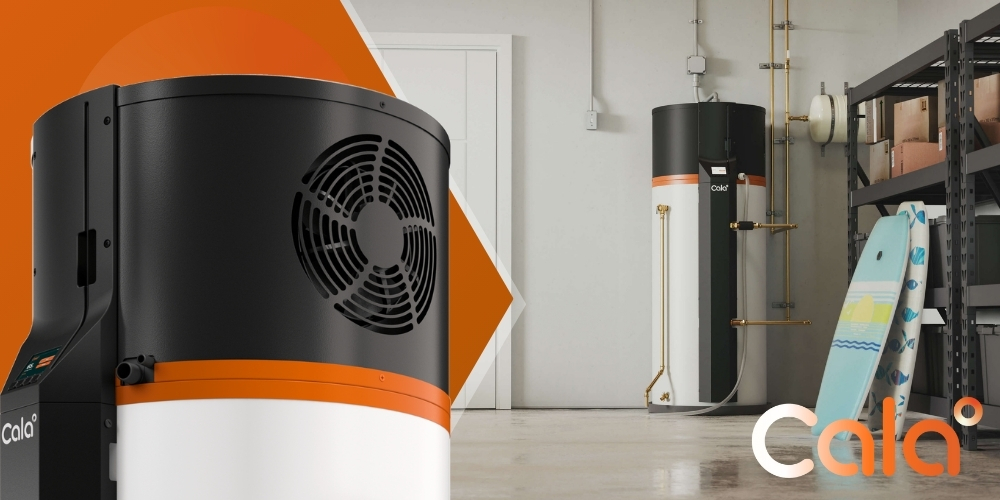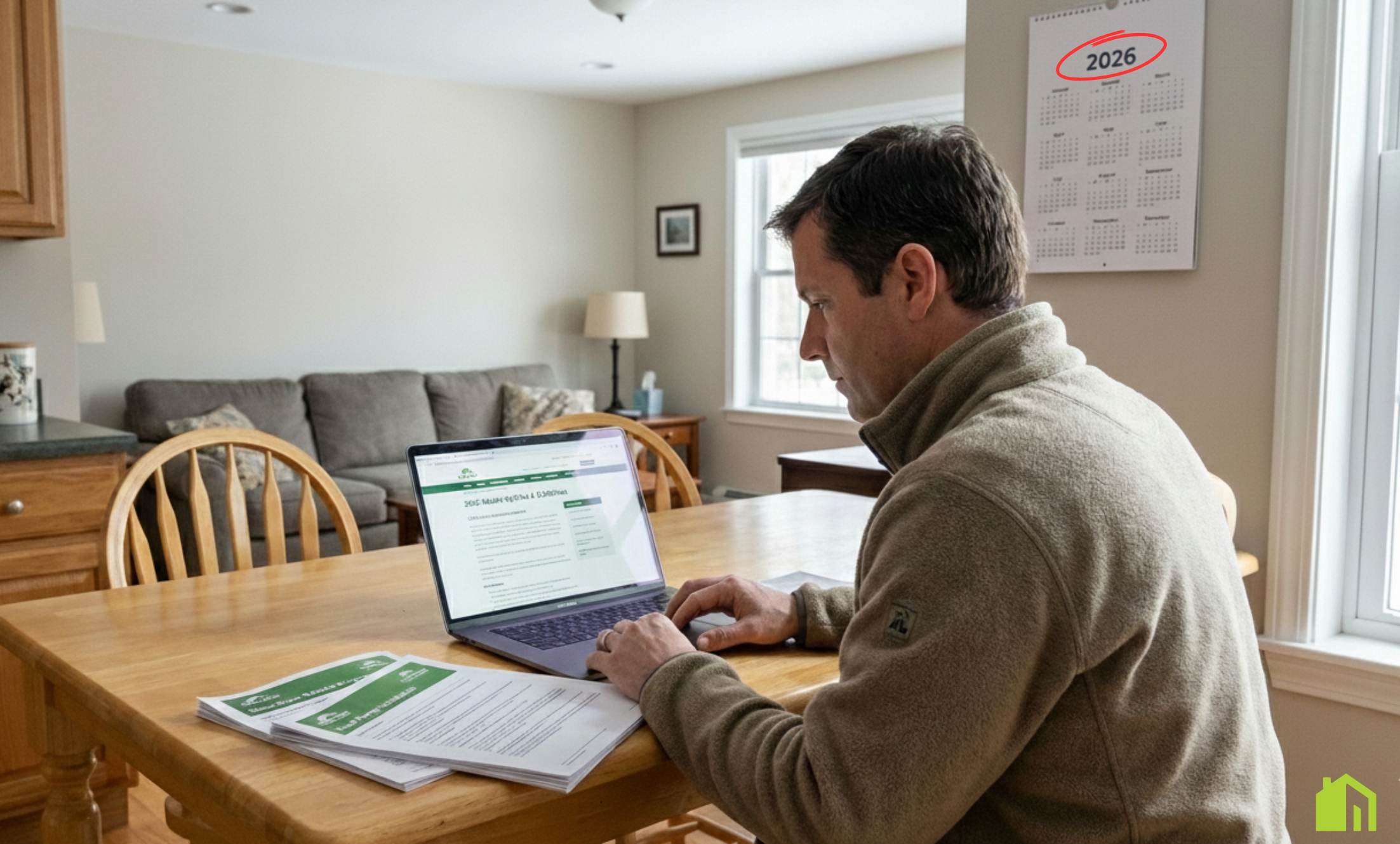Dehumidifier Installation Guide: What Homeowners Should Expect

Intelligent Heat Pump Water Heaters for Massachusetts Residential Homes — Why SumZero Selects Cala
By SumZero Energy Systems — Massachusetts’ #1 Heat Pump Installation Team
Picking a new water heater once involved a simple decision between gas and standard old electric, praying the hot water wouldn't be gone when there were two showers in a row. That's no longer the case. Now, the ideal solution for the majority of Massachusetts homes is a smart heat pump water heater (HPWH). This isn't the typical hybrid of which you might have heard, but a rather new breed of unit that adapts to your home's schedule, accommodates your energy usage, and maintains comfort consistently while consuming a lot less energy.
When homeowners want to have it exactly right the first time, our team is discerning about what products we choose. We consider the landscape and inspect the details before determining that they might work with Cala, a company that produces a high-technology hot water heater that modern homes need: intelligent, consistent, and efficient hot water — installed properly. This article describes why this alliance matters, how the tech benefits your home, what you should expect from our installation, and the handy information (rebates, credits, fit questions) homeowners inquire about daily.
Why This Alliance Is Important
(and What It Does for You)
There are two parts to a successful hot water solution:
Great technology
A system that makes you comfortable and uses less energy.
Great installation
Design, placement, airflow, electrical, condensate handling, commissioning, and long-term support.
Cala provides a tailor-built, smart HPWH platform. SumZero provides actual-world experience so that it works perfectly in real Massachusetts homes.
Together, we provide three things homeowners report wanting:
Accurate hot water at peak periods without guessing.
Cheaper monthly energy bills without compromise on comfort.
It is a future-proof solution that addresses the trend towards greener, all-electric homes.
Simply put: We get hot water. We know how to properly install heat pump technology. This combination makes a water heater upgrade a smart, long-term decision.
The Homeowner's Dilemma That We Are
If you have had a gas or a typical electric water heater, then you know the problems:
Hot-cold swings on hectic morning routines.
Higher electricity bills than hoped for.
No real insight, no real control.
A replace cycle that is experienced as "buying the same thing again."
Typical hybrid: Heat pump water heaters perform better, yet they still react: They delay until the tank cools off, then warm it up again. Homeowners averred they desire a system which thinks ahead—a unit which is a breeze to operate, handles peak load graciously, and does not make them compromise.
They fill that gap, which is why we work with them.

Why a Smart HPWH is Different
A standard electric water heater makes heat by passing an electric element, a giant toaster coil, through the tank. A heat pump water heater does it another way: it takes heat from the air it lives in and puts it into the water. Because it costs less energy to move heat than create it, heat pump water heaters run on much less power than typical electric ones. And they avoid burning gas, venting, and pollution.
A smart HPWH goes one step further:
It adapts to your home's schedule (morning showers, nighttime laundry) and preheats when demand isn't yet high.
You can use the app to check, plan, or increase hot water whenever you want.
It has a compressor that can change speed to fit what you need (not just "on/off").
It is achievable with a mixing valve holding water at the proper warmth for improved efficiency and then providing a sustained, safe warmth for usage. This is also possible with the availability of additional warm water at peak usage times.
It goes nicely with a contemporary home — primed for solar, time-of-use, and information you can view at a glance.
Result: more stable comfort, less energy use, improved control.
Why a Smart HPWH is Different
From what is visible on-site, there are three things certain for homeowners regarding the points of Cala:
1) Ease That Is Effortless
Consistent hot water at peak use is the ultimate test. Through forecasting demand and using a mixing valve, Cala maintains a steady supply. That results in less "uh oh" when two showers coincidentally happen at once or someone turns on the dishwasher.
2) Controls That You'll Ever Use
App functionality is key when done properly. You can check if there's hot water, turn up the heat for guests, view energy usage history, or simply set it and leave. As installers, we appreciate performance data — it allows us to address little issues before large ones form.
3) Future-Ready from Day One
Massachusetts is going towards clean, electricity-based homes. Cala's strategy combines well: it is scalable for solar power and accounts for time-of-use rates when needed. If you foresee solar energy at some time, or already have it, this water heater won't stop your home from being efficient.
4) A Company That Stands Behind Its Product
Cala backs every unit with a 10-year parts warranty and 3-year labor warranty — a strong sign they stand behind both the technology and the people who install it. At SumZero, we respect that kind of commitment because it mirrors our own approach: taking care of homeowners and supporting our partners with the same level of trust and accountability.
What SumZero Offers As Your Installer
(Why It Matters)
Even the best system won't work so great if installed wrong. Our task is getting your new HPWH working perfectly inside your home, not on a drawing board. This is what our approach is:
Right-size design.
We measure how much water your home needs and discuss the high-flow fixtures, filling bathtubs, and washer usage.
Best installation and ventilation.
HPWHs require air to make the heat move. We consider the room size, doors, vents, and — when necessary — ducting solutions for high performance and low noise.
Clean handling of electricity and condensate.
Safe power, tidy routing, and a trustworthy drainage plan are essential.
Commissioning correctly.
We don't just "turn it on." We verify performance, position the mixing valve, help you with the app, and verify your comfort objectives.
Rebates, credits, and financial assistance.
Mass Save, federal 25C, and the 0% HEAT Loan (if applicable) — we'll help you with that.
We take special care.
Our teams respect your home, protect your floors, and leave the place nicer than they found it.
Aftercare you can count on. Questions years down the road? We're here. The whole concept of a smart system is long-term confidence, not a one-day installation.
Costs, Incentives, and Lifetime Value
Two parts matter here: upfront cost and operating cost.
→ It is a better unit than a standard electric or simple hybrid. Tax credits and rebates make a big difference. A lot of Massachusetts homeowners rely on the 0% HEAT Loan for easier payments.
→ Month after month, the intelligent HPWH's effectiveness is where the value lies. By transferring (not creating) heat and by scheduling heating intelligently, homeowners consistently experience significant decreases in water-heating energy consumption — particularly relative to resistance electric, and many times relative to gas or delivered fuels when full costs are factors.
If you'd like figures specific to your home (household number, showering usage, energy costs), we'll do the math at your consult and provide you with a clear estimate of payback, lifetime cost saving, and the rebates for which you qualify.
Are Smarter Heat Pump Water Heaters Good for Your Home?
It is feasible for many Massachusetts homes. We will cover:
→ Household size and routines. Families with up to about 5 people usually do well with the standard setup; we will give advice for larger families or special situations.
→ Space and ventilation. We check the space, door vents, or ducts if necessary, and ventilation so the system operates properly.
→ Location. Basements are typical, as are utility rooms. As the unit functions, it removes air that feels like a dehumidifier — a typical plus for basements.
→ Electrical. We check panel capacity and proper wiring; no installation day surprises.
→ Future plans. Now or in the future for solar? Time-of-use rates? We'll put the system on so it grows with your home.
[[cta-heatpump]]
Why Is Cala Different from "Traditional Hybrids"?
✪ Control and Convenience:
Cala integrates intelligent tech with a mixing valve to remain comfortable, even when it is busy. Most standard hybrid units have simple modes and react only when the tank becomes chilled.
✪ Care and Trust:
Performance insights help you recognize problems early on and keep you on your feet for surprises. Traditional deployments are mostly "wait and see."
✪ Timing and Efficiency:
Variable driving and improved scheduling assist in energy saving with the maintenance of comfort. Ordinary hybrids operate more often and at undesirable times.
✪ Future-Ready
The design of the Cala accommodates with solar power, intelligent homes, and plans for utilizing electricity. Most older hybrids were not built for that usage.

What to Expect with SumZero
(From the First Call Through the First Shower)
✪ Talk & Pictures
We'll first glance at your objectives and take some fast photos of the current installation: the water heating unit, panel, and surrounding room.
✪ Right-Fit Design
We fit your hot water consumption and available spaces to a design which we endorse.
✪ Chaplain: A Comprehensive
Your quote is going to be transparent, includes information for installation, accessories, and a checklist for incentives. The paperwork assistance takes care of our end.
✪ Professional Installation
Licensed, insured, and detail-orientated. We dispose of the old unit, prepare the site, install and commission a new system, and leave the site tidy.
✪ App Introduction and Instructions
You'll discover how to see hot water supply, schedule increases, and view consumption — without being "technical."
✪ Support and Help
We're your long-term partner. Got a question? You call us — that's what homeowners deserve from the #1 heat pump installation company.
Common Questions We Get
(And Easy Answers)
Smart heat pump water heaters move heat from the surrounding air into the water instead of generating heat directly. This makes them up to three to four times more efficient than standard electric models. Cala’s intelligent system takes it further — it learns your household’s patterns, preheats before busy periods, and gives you app-based control to monitor or boost hot water anytime.
Most hybrid water heaters react when the tank cools. Cala predicts when your home will need hot water and heats proactively, saving more energy while maintaining comfort. It also features a variable-speed compressor, integrated mixing valve, and performance monitoring portal, giving both homeowners and installers a smarter, more reliable experience.
Savings depend on your energy source and usage, but many Massachusetts homeowners cut their water-heating costs by 50–70% when switching to a heat pump system. Cala’s intelligent controls add even greater efficiency. Add Mass Save® rebates, federal 25C tax credits, and potential 0% HEAT Loan financing, and most families see real payback within just a few years.
Yes — most Massachusetts homes are a great fit. Cala’s 65-gallon design comfortably serves households up to five people and can prepare up to 90 gallons ahead of peak use. The system needs adequate space and airflow, similar to a dehumidifier, and our team at SumZero handles every detail — from placement and ducting to electrical and performance checks.
SumZero Energy Systems is Massachusetts’ #1 heat pump installation team, trusted for precision, transparency, and high-quality service. We manage every step — design, installation, rebate paperwork, app setup, and long-term maintenance — so homeowners enjoy smarter comfort and lasting confidence. With SumZero, you’re not just buying equipment; you’re gaining a partner who stands behind it.
Why We Feel Secure Recommending This to Massachusetts Homeowners
We have a simple promise: we only install solutions that we would use in our own homes. Cala’s approach — being smart, having control, and being ready for the future — matches what we have learned from many talks with homeowners in the state. Together with SumZero’s careful installation standards and ongoing support, this water-heating upgrade makes sense right away and will last well with your home. Cleaner heat. Smarter comfort. Fewer bills.
Ready to Take the Next Step?

To learn more about Cala’s technology and vision, visit Cala Systems.
What to Expect From Dehumidifier Installation in Massachusetts
Excess moisture is a silent enemy in countless Massachusetts homes. It quietly fuels mold growth, ruins basements, and contributes to uncomfortable living conditions. Fortunately, a professionally installed dehumidifier can transform the indoor environment. But before you dive into a dehumidifier installation project, it’s important to know what to expect—from initial assessment to long-term maintenance. This guide walks you through the full experience so you can make informed decisions that support better air quality and home comfort.
Understanding the Purpose of Dehumidifier Installation
A dehumidifier isn’t just another gadget. It’s an integral part of an effective air quality system, helping to create a healthier and more comfortable home by reducing humidity.
- Stabilizes indoor humidity levels
- Reduces the risk of mold growth
- Protects structural materials like wood and drywall
- Makes air conditioning more efficient
- Reduces dust mites and moisture-loving pests
Over 50% of homes in New England have elevated basement humidity levels for at least six months of the year.
When excess humidity goes unchecked, it doesn’t just feel clammy—it can also damage the home’s value over time. A tailor-fit dehumidifier alleviates all that.
Preparing Your Massachusetts Home for Dehumidifier Installation
Getting ready for installation starts long before the equipment arrives. A thoughtful plan ensures the system works efficiently from day one and addresses your home’s specific moisture problems.
Evaluating Moisture Levels and Trouble Spots
Homeowners often discover signs of excess moisture without realizing how widespread the problem may be. An assessment pinpoints the areas most in need.
- Monitor humidity levels with a hygrometer. Ideal range: 30–50%
- Check for musty odors, especially in crawlspaces or basements
- Inspect window frames for condensation
- Note any visible signs of surface mold or mildew
Choosing the Right Location for Maximum Results
Where you place the dehumidifier matters. A whole-home dehumidifier needs unobstructed airflow and easy access for maintenance. In Massachusetts homes, common installation sites include:
- Basements with history of dampness
- Utility rooms near central HVAC ductwork
- Crawlspaces prone to moisture buildup
One of the most overlooked mistakes is placing the dehumidifier in a location without proper drainage access—leading to overflow issues and system inefficiency.
Sizing and Customization
There’s no substitute for a properly sized system. An undersized dehumidifier can run constantly without results, while an oversized unit may waste energy.
Key factors for selecting the right unit:
- Square footage of the treatment area
- Typical moisture level for the season
- Basement insulation and ventilation status
- Integration needs with the home's existing IAQ solutions
Once the right system is selected and location prepped, it’s time for installation day.
[[cta-heatpump]]
The Installation Process and What Happens After
The actual installation is typically completed in a day, but the value comes from how smoothly your lifestyle adjusts afterward. Knowing what’s involved helps things go much more smoothly.
What Happens During Installation
The installer will do more than just place the unit. For whole-home systems, installation may involve connecting to existing ductwork, wiring drainage, and configuring controls.
You can expect:
- Possible drilling to install drainage lines
- Electrical work for new outlets or safety switches
- Condensate pumps or gravity drain lines for effective water removal
- Duct attachment if integrating with your heating/cooling system
Installers will also test the system and show you the controls before finishing up.
Understanding System Settings
Most modern dehumidifiers offer automatic features that adjust to changing conditions. It’s helpful to understand the basics:
- Set your desired humidity level (typically between 40–50%)
- Learn how air circulates through the home
- Monitor filter clean alerts or drainage performance
A surprising benefit of dehumidifier systems is their ability to improve your HVAC system’s efficiency, allowing it to cool your home more effectively with less energy use.
Post-Installation Tips for Long-Term Performance
Even the best system needs some care to stay effective over the years.
To support ongoing home humidity control:
- Clean or replace filters every 2–3 months
- Check and flush drainage lines seasonally
- Inspect for frost buildup during colder months
- Review system performance at the start of each spring
These simple practices help extend the life of your investment and protect indoor air quality year-round.
Protecting Your Basement and Boosting Home Air Quality
Basements in Massachusetts are particularly prone to excess moisture due to geographic and seasonal conditions. Targeting this area can be key to whole-home comfort.
Solving Basement Moisture Issues at the Source
A properly installed basement moisture solution involves more than ventilation. Dehumidifiers are uniquely qualified to handle damp, earth-contact surfaces and the lack of airflow common in basements.
Top benefits in the basement include:
- Prevents musty smells and visible mildew
- Protects stored items from damage
- Reduces potential allergens and irritants
- Makes finished basements more livable
Nearly 70% of unresolved indoor mold issues in homes begin in their basements—often out of sight and out of mind.
Improving Indoor Air Quality Throughout the Home
When moisture is reduced in one area, your whole home feels the difference. A balanced IAQ solution includes dry air, clean ventilation, and temperature control.
Ways dehumidifiers support other air quality improvements:
- Reduce dust mite populations, which are humidity-dependent
- Limit spread of mold spores through ductwork
- Create a drier environment where air purifiers work more effectively
Homeowners also notice their thermostats staying closer to the setting—because the air feels lighter and more comfortable without excess humidity clinging to every surface.
Leveraging Rebates and Energy Advice
Massachusetts homeowners may qualify for rebates or consultation programs when improving indoor air systems with energy-efficient upgrades.
Programs like Mass Save® offer guidance on high-efficiency dehumidifier installation, letting you recover part of your investment through energy savings and support services.
Check qualifications for:
- Low-income energy assistance
- Home Energy Assessments
- Eligible product rebates
Always verify your contractor has experience with Massachusetts-specific building codes and rebate support.
Final Thoughts
Installing a dehumidifier in your Massachusetts home is a smart, long-term step toward creating a healthier, more comfortable living environment—especially when moisture challenges persist season after season. Whether it’s to protect your basement from mold, boost the performance of your HVAC system, or simply enjoy fresher air across your home, a professional dehumidifier installation delivers benefits you’ll notice right away and appreciate even more over time.
Improve air quality and comfort year-round with a custom whole-home dehumidifier—your key to effective home humidity control in Massachusetts basements and beyond.
Get Humidity ControlYou Might Also Like…
Continue learning with handpicked articles that inform and inspire.
Not Sure Where to Start? We’ll Guide You
Let our experts design the right heating and cooling solution—customized for your comfort, your layout, and your energy goals. No pressure. Just clarity.
Request FREE ESTIMATE









